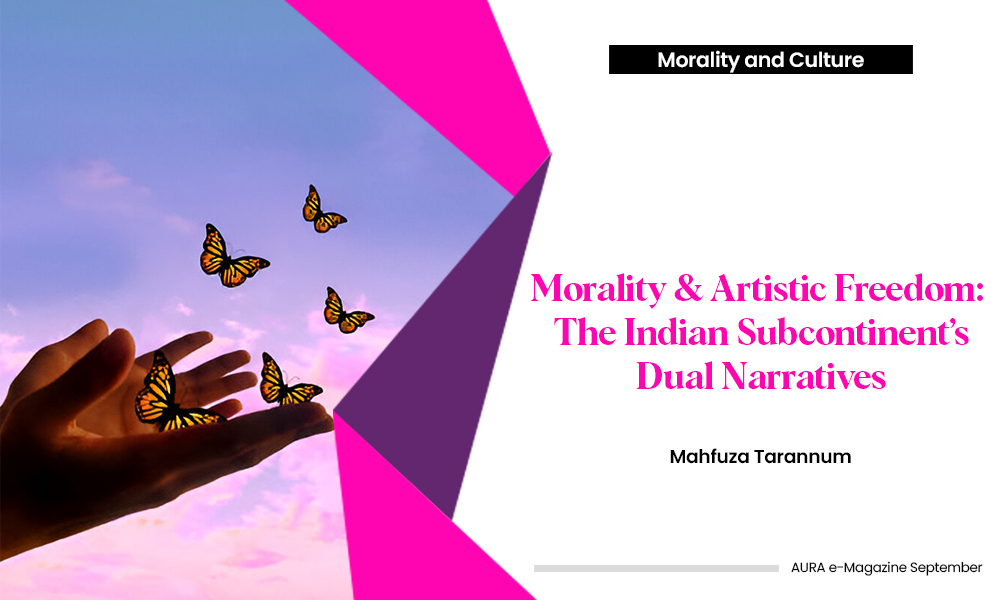Morality is a system of principles and values concerning what’s regarded as good or bad behaviour in society. These principles help individuals differentiate between good and bad conduct and are frequently used to guide decisions, actions or rulings. Cultural, religious, philosophical and personal beliefs can affect morality and play an important role in maintaining social order and promoting harmonious coexistence.
In many cultures and religions, freedom is closely related to morality. Their doctrines hold that genuine freedom comes from moral discipline, following a divine command, and the capacity to do as you wish. Morality promotes freedom by enabling people to make choices that benefit not just themselves but also other people and society as a whole. Adhering to ethical principles reduces the likelihood of people engaging in activities that cause harm, conflict, or social breakdown. It creates a more safer & predictable setting, allowing people to pursue their own objectives without fear of injustice, oppression, or uncertainty.
However, freedom and modernity have occasionally been exploited in the Indian subcontinent to push artistic boundaries in ways that some cultures deem objectionable or unsuitable. This tension between art expression and cultural norms frequently leads to arguments and disputes about the boundaries of freedom in a culture as diverse as India. The painting of naked Hindu deities by Maqbool Fida Hussain is one example of art used in the name of freedom. Maqbool was receiving harsh criticism for his portrayal. His art was viewed by many as derogatory and hurtful to Hindu feelings. The ensuing dispute demonstrated how modern art may be at odds with religious sensibilities and resulted in demonstrations, legal action, and even vandalism of his exhibition.
In contrast, the Bangladeshi student movement of 2024 has expressed itself and resisted via the use of calligraphy and other artistic mediums. With its unique fusion of artistic and linguistic components, calligraphy developed into a potent medium for spreading ideas of resistance, solidarity, and the struggle for freedom. Bangladeshi students employed calligraphy as a tactic to mobilise public opinion, uphold cultural identity, and finally win freedom in addition to using it to support themselves against a fascist regime morally. Due to its visual appeal and cultural resonance, calligraphy has endured as a symbol of resistance and played a significant role in the nation’s quest for its second independence.

The media’s role in spreading some narratives, such as hate speech and fake news, is a major source of worry. For this reason, India was listed as the nation that spreads fake news the most, according to the World Economic Forum. For instance, it has recently come to light that certain Indian media channels are disseminating inaccurate information regarding the burning of Hindu temples in Bangladesh. According to the allegation, the fake news was spread to stoke anti-Islamic emotions and create conflict among the community. Due to Hindu groups’ mistaken belief that Muslim labourers in West Bengal are a part of the greater Muslim population, which is said to be the cause of the incidents, there have been violent episodes in Odisha as a result.
Among other media, bollywood films and item songs have always been contentious. Songs like “Sheela Ki Jawani” (Tees Maar Khan), “Munni Badnam Huyi” (Dabangg), and others frequently encourage immorality under the pretence of bravery, freedom, and empowerment. Bigg Boss and Splitsvilla are two examples of reality television shows regularly condemned for encouraging toxic behaviour and vulgarity in the name of entertainment. Concern and controversy have also been raised by the Pakistani TV program Barzakh, which promotes LGBTQ themes that are immoral and at odds with traditional norms. Critics contend that the program is disseminating viewpoints that are at odds with humanity and society standards, which could harm young people. However, there are still films like Taare Zameen Par (2007), which highlighted the moral obligation of comprehending and nurturing children with learning disabilities, fostering empathy and compassion, and Lagaan (2001), which promoted themes of unity, perseverance, and moral integrity in the face of colonial oppression. The lyrics “Saari Umar Hum” (3 Idiots) strike a profound chord with themes of individuality, independence, and the value of morality. The song’s lyrics, especially the line “Rishwat dena to khud papa ne sikhaya,” make fun of the fact that parents frequently set a negative example for their children and vice versa.
Whether certain literary works from the Indian subcontinent encourage readers to become immoral and negative under the pretence of modernity and freedom of speech is still disputed. Critics frequently claim that certain modern works of literature, especially those that address themes of sexual liberation, defiance of societal conventions, and existential dread, might harm society’s moral foundation. For instance, the contentious book “Shame” by Taslima Nasreen depicts the persecution of Hindus in Bangladesh.The work has drawn criticism for its vivid and occasionally violent descriptions of brutality and suffering, which some claim have the potential to spread negativity and hatred among the community.
However, Khushwant Singh’s “Train to Pakistan” is regarded as a classic because of its potent depiction of concepts like love, brotherhood, & unity against the backdrop of pervasive hatred & separation. It serves as a reminder that these virtues—especially during communal strife—are essential for breaking the cycles of violence and hatred.
The boundaries between modernism, freedom of speech, and morality are sometimes blurred in the context of the Indian subcontinent, which sparks contentious discussions over the significance of particular literary works. Some contend that these pieces encourage pessimism and immorality, while others view them as essential tools for intellectual freedom and social transformation. The difficulty lies in balancing advancing intellectual and creative freedom and safeguarding societal values.
Artists hold a special place in society since they are frequently viewed as creators and commentators. In their art, morality and freedom have a nuanced and intricate relationship. The ability to express their ideas, question conventions, and push limits is afforded to artists. But this freedom also entails responsibility. Art can sway public opinion and cultural narratives. It may also inspire, provoke, and affect people. Artists must thus think about the moral implications of their creations. In art, balancing morality and freedom requires conscious and deliberate decision-making rather than the imposition of rules. Artists can create deeply impacting and morally based work when they carefully strike this balance.
In the end, an artist’s ability to balance artistic license with moral responsibility determines the overall influence of their work. Artists that can strike a balance between these factors can produce visually striking art that also has social and ethical significance.


0 Comments